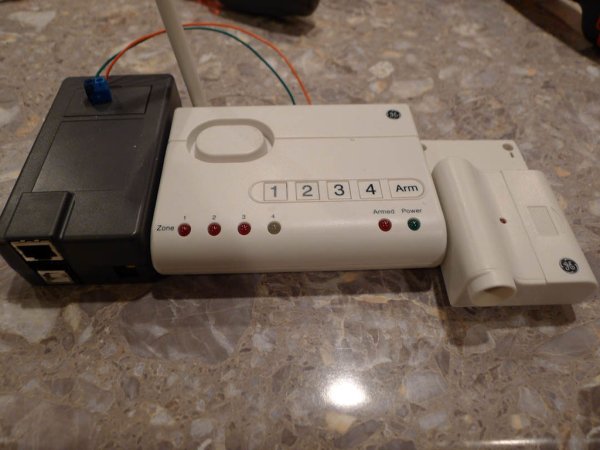You know that feeling of driving away from your house almost getting to work and saying “Now Did close the garage door?” . I hate that feeling and seeked out to resolve it in the smiplest/cheapest way I could. The starting point was of course Arduino. This project ended up being simpler than I could of imagined but it was not my best effort (as it was my first real project making something useful with the Arduino).
Step 0: Sync the garage door monitor to the base station. Unplug everything then.
Step 1:
The first thing to do is unscrew the two screws in the back and the one under the battery cover. Then you can pry the back off (Be careful as getting the battery contacts out is reallyyyy sorta a pain.
Step 2:
Flip over and find the LED for zone 1 (labeled 1!). Then turn it back to the PCB side and find the contacts. I soldered one wire for where I found the ground was (Green) and another red wire for the -. I found which was which by trial and error using my arduino.
NOTE: Soldering there’s wires are hard, i dunno if it was my crappy soldering iron or what but it was hard to heat up the metal already on the PCB and get my wires soldered to it on a solid way. If you are enterprising enough you can solder two wires to each of the zone alarms and have this tweet you when say someone is detected by their wireless motion sensor, or the door sensor goes off etc…
Step 3. I used a dremel to edge out some of the plastic on the battery cover so the wires could come out from the PCB into the battery area. This is where I also attached a (superficial perhaps) board to connect more wires to that ultimately lead to the screw terminals attached to the arduino. The idea of the board was make sure there was slack in the system so the wires don’t get yanked out of the delicate soldering on the LED pins on the PCB of the alarm base station.
Step 4: Drilling out the battery cover. This is simple drill I used and made the holes so the wires could pop out of it…
Step 5: Mark where the screw terminal should go in the project box and drill the holes, then on the other side solder in the screw terminal with the wires that will goto the arduino/ethernet controller.
Step 6: Finally put in the arduino and ethernet controller shield into the project box and connect the wires to ground respectively and analog 0. Then close the box up.
#if defined(ARDUINO) && ARDUINO > 18 // Arduino 0019 or later
#include
#endif
#include
//#include Only needed in Arduino 0022 or earlier
#include
byte mac[] = { 0xDE, 0xAD, 0xBE, 0xEF, 0xFE, 0xED };
byte ip[] = { 192, 168, 0, 23 };
Twitter twitter("read on how to set this");
char msg[] = "Garage Door is OPEN";
char msgStartup[] = "Garage door monitor is online!";
boolean failed=false;
boolean blinkTime=false;
boolean doorOpen=false;
int alertcounter=0;
int resetcounter=0;
int diodePin=0;
int val;
int randomValue;
void setup()
{
delay(1000);
Ethernet.begin(mac, ip);
Serial.begin(9600);
pinMode(13, OUTPUT);
Serial.println("connecting ...");
sendStartupTweet();
}
void sendStartupTweet()
{
if (twitter.post(msgStartup)) {
int status = twitter.wait();
if (status == 200) {
Serial.println("OK.");
} else {
Serial.print("failed : code ");
Serial.println(status);
failed=true;
}
} else {
Serial.println("connection failed. Startup");
failed=true;
}1. Project Enclosure for the Arduino + Ethernet shield from amazon.
2. Arduino, in my case the old Diecimila. You all know and love the arduino, found online about 23$
3. Arduino Ethernet shield ~ 40$
4. GE Choice Alert wireless-control center
5. GE Choice-Alert wireless garage door sensor
6. Screw Terminal
For more detail: Twitter garage door using the GE Choice ALERT system & Arduino

